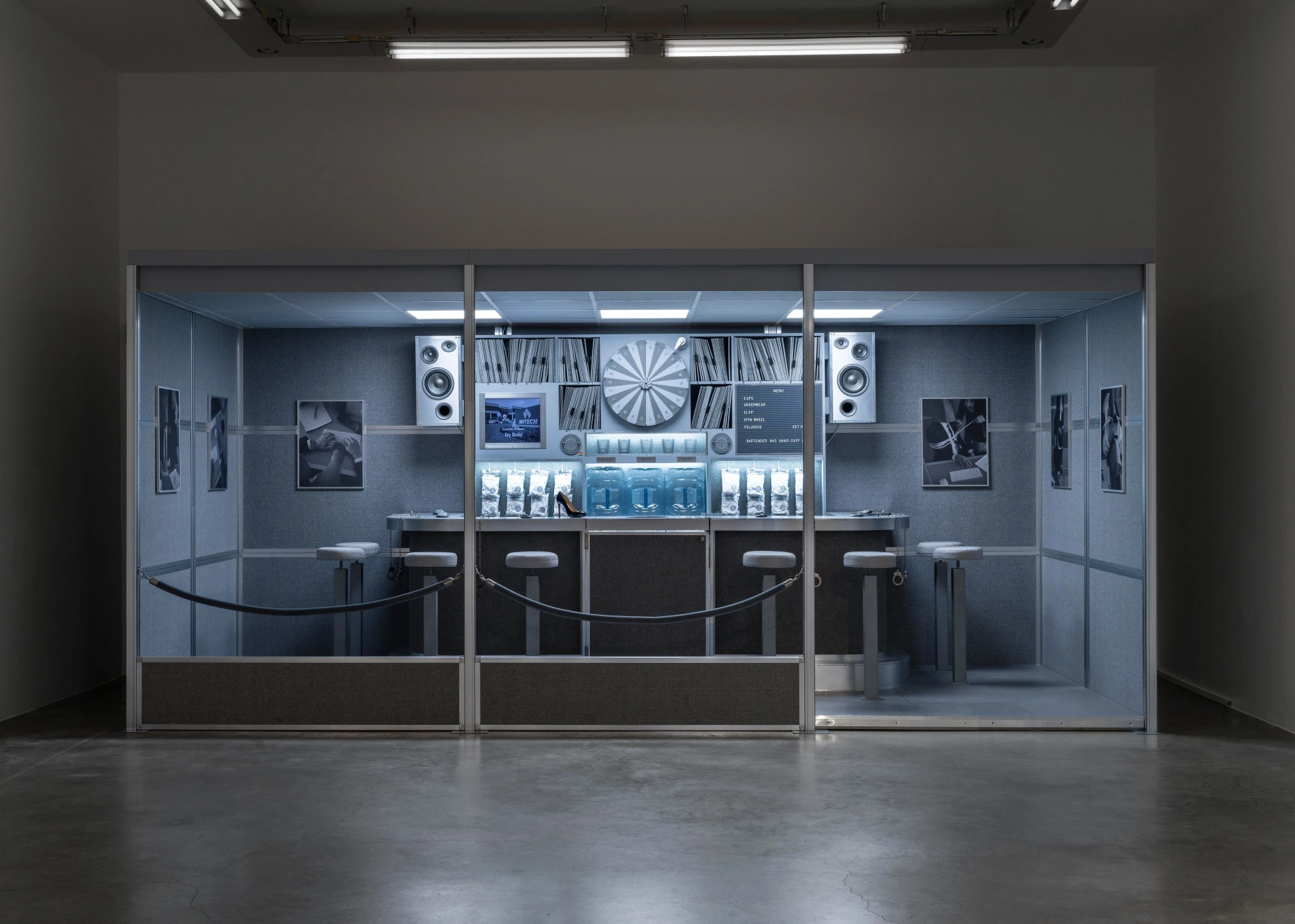Open: Tue-Sat 10am-6pm
76 rue de Turenne, 75003, Paris, France
Open: Tue-Sat 10am-6pm
Visit
Nick Doyle: Business, Pleasure, Pressure, Release
Perrotin Marais, Paris
Sat 1 Feb 2025 to Sat 8 Mar 2025
76 rue de Turenne, 75003 Nick Doyle: Business, Pleasure, Pressure, Release
Tue-Sat 10am-6pm
Artist: Nick Doyle
NSFW
“Work is the curse of the drinking classes.” -Oscar Wilde
Artist Nick Doyle (b. 1983) has long explored the perverse machinations and lurid fantasies of everyday American life. Through meticulously crafted vignettes of prosaic objects laden with strange melodramas and desperate longings, Doyle’s deadpan scenes tease at the gears of the machine that feeds us. Business, Pleasure, Pressure, Release, his fifth exhibition with Perrotin, takes up the playpen of white-collar employment: office space.
A fantasy of American labor may be of a worker in denim, a Marlboro Man with his sleeves rolled, but the truth is that the modern office is itself a decidedly American invention. Landlines, cubicle dividers, filing cabinets—the buzzy appliances of the early twentieth-century office— were all concocted in the United States through a chop-shop style recombination of old forms. While the first sites to adopt the devices are known for interminable paperwork and sagging middle management, the appliances enabling this work were glorious little monsters.
Take the landline telephone: to produce the first phone, Alexander Graham Bell (then based in the US, a few years away from American citizenship) fiddled with a dismembered ear from a Boston cadaver. As the delicate bones and membrane vibrated, animated by Bell’s voice, an attached stylus trembled, etching the quivers onto glass. Add a transmitter and a few tweaks, and an office mainstay was born. The first telephone switchboards were MacGyvered together using teapot handles and bustle wire, from the late nineteenth-century undergarment de rigueur. The device was a chimera, a surrogate body frankensteined into office gear of the future.
Consider even that stalwart of every bureaucratic environment: the filing cabinet. Before its invention at the end of the nineteenth century in Chicago, errant papers—letters, pamphlets, newspapers—were stitched together to become archived, bound, and fixed in a sequence. In this era, to find a single page, heavy bound volumes needed to be hauled and poured through, usually without the aid of an index. The word file, derived from the Latin filum, or “thread,” bears a vestige of the practice of sewing pages together, etymologically linked to the “single file” march of people and livestock in tidy lines, and the military term “rank and file.”
The filing cabinet—a hybrid of a fire-proof safe and cabinet—cast papers free of their bindings. Enter a sea of tabbed manila folders, designed for ever-more efficient recall, transport, and reshuffling. This fervor for the acceleration of productivity was ratcheting to a delicious end, or so it was promised: in 1930, economist John Maynard Keynes predicted that the fifteen-hour workweek would arrive by the end of the century.
The abridged workweek never came. Instead, the very devices designed to save us from the office were enlisted as co-conspirators in ever expanding tasks. Doyle teases wryly at our present predicament in the 2024 installation Human Resources, a grey enclosure that functions as a game stage. Fused panels from cubicles and drop ceilings define the structure’s form; its monochromatic interior is outfitted with bar stools, fetish files, and a prize wheel. Throughout the exhibition, Human Resources will be activated, a site for power play and the exchange of fluids. Here, Doyle has replaced the motivational posters typically found in HR offices with scenes of S&M lite—rope and foot action delivered at your desk. You can even purchase a memento of his artistic labor: Doyle’s own used underwear is available at the bar at $20 a pair.
Where is the escape hatch? Where do we go from here? In an ongoing series titled Executive Toy, Doyle models scenes of potential release. Executive toys, sometimes known as desk toys, serve as object lessons. Newton’s cradle is a popular variety, a pendulum of metal balls that swing and crash in steady rhythms, producing a pulse of collision. In 1952, Bell Labs graduate student Marvin Minsky started making executive toys whose sole function was to turn themselves off. Science fiction author Arthur C. Clarke wrote of Minsky’s creations, “There is something unspeakably sinister about a machine that does nothing—absolutely nothing—except switch itself off."
In Doyle’s formulation, the Executive Toy series offers sequences of working men operated by a hand crank. Executive Toy: The Final Chapter (2019) portrays a sedan becoming a hermetic system: exhaust pipe and car interior are connected by hose. In Lonely Road (2019), half of a dismembered car takes the road; the driver has slipped a paper bag over his head; the hint of a necktie peeks through from under the sack. In the current exhibition, American Boy Doll: John (2025) a miniature man is inlaid inside a briefcase, head face down and covered with a paper bag. John comes with accessories: shoes, martini, and yet a smaller briefcase.
If the j-o-b sounds like horror, it’s because it is. But horror always starts with optimism. Need to get away? Need cash? Slip into this little sliver of hope, let it slide over you like bubbly water in a warm tub or salt waves lapping the beach. Get in.
Sara O’Keeffe, senior curator, Art Omi








